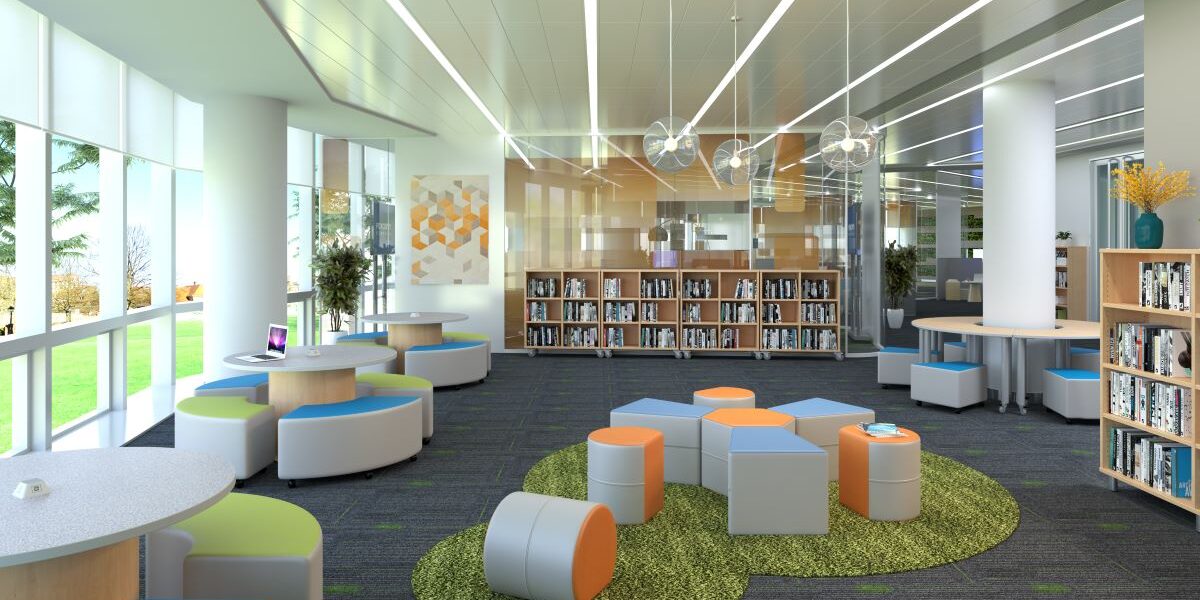The library is the space I have seen change the most in the past 30 years. Gone are the days of tall, dark library shelving stuffed with volumes of books, study carrels, heavy wood tables and chairs. Instead, the library is a space embracing technology, a center hub of explorative learning within the school, where students are no longer “shushed” but encouraged to collaborate in teams with all voices heard.
I’ve seen some mistakes (some of those mistakes I made myself), when designing the learning commons in the past 30 years and know I can help administrators and librarians learn those lessons without breaking the budget. I know that the most expensive spaces to outfit in most schools are the library, the cafeteria, and the gymnasium(s), with the customer’s expectation for the furniture to hold up for 20+ years. I’ve also seen how much the community, technology, budget constraints and the ever-changing pedagogy trends affect the function and purpose of a library.
I’ve designed libraries which were open above with visual lookouts, libraries without permanent walls or circulation desks, 100% mobile libraries with interior glass garage doors, and libraries that function as a cafeteria during lunch. Some schools renovate existing libraries to include other functions: a technology bar, a coffee shop with lounge seating, a testing or computer zone, FACS/Makerspace zones, Lego/Robotics zones, Green Screen Rooms, Production Labs and glass think tanks.
No matter your unique needs, there are five “must-haves” for this space:
- Shelving
With the every-changing needs in a school from year to year, make sure you consider how much shelving you need based on the volumes you circulate. We have seen a shift to mobile shelving, both straight and curved, made of solid wood, laminate or even steel in shorter heights for visual line-of-sight. Because schools need their shelving to last for at least 20 years, make sure you purchase from a reputable manufacturer who has experience with K-12 demands with a 15+ year warranty. If budget is a concern, try to reduce the number of volumes on hand or consider just replacing the interior shelving with mobile alternatives. Don’t worry about matching the wood color, since two-tone shelving or mixing and matching metals is the trend right now.
- Circulation Desk/Info Desk
Thinking about all the possible ways a librarian spends his/her day will help you select the right pieces of furniture. Perhaps it is a mobile desk instead of a built-in casework desk, allowing the librarian to move their desk to where they are needed in the space. Instead of incurring the expense to rip out a built-in circulation desk, add a cart with a shelf on top. Use a mobile table with a mobile book drop cart at the entrance/exit. Convert study carrels into an information desk or shelf check-out station.
- Classroom/Learning Zone
Because this space is where teachers bring their full classrooms to use, try to make it feel different from their standard classroom setting, so it becomes a “treat” for instruction. Select different shapes of tables in a café height markerboard top with stools, creating a fun collaboration zone. Add casters onto tables or use flip-n-nest tables and chairs for flexibility and allowing for quick transitions to different space set-ups (lecture vs. small group vs. Socrates discussion).
Choose a style and color chair other than what is in the classroom: soft seating, café stools, caster chairs, or active seating. Laser cut a mascot or school logo into the back of a wood chair to show school spirit. If the community uses the library for large group events, consider adding extra high-density stacking chairs, which can be stored when not in use.
- Small Group/Independent Work Areas
You want to create many small group areas around the library, so all students feel like it is a place to rejuvenate, learn, or complete head’s down work. If your learning zone is comprised of mobile tables and chairs, you can rearrange furniture to create small group work. For a comfy reading spot, place an armless vinyl upholstered chair at the end of shelving. Set up four lounge chairs or vinyl upholstered four-leg benches in a campfire configuration with side laptop tables where larger groups can relax while collaborating. To reduce energetic conversation noise, use moveable screens or two-sided mobile markerboards with upholstered fabric on the opposite side to absorb sound and create privacy.
If you have an architectural feature you cannot change, consider making this a unique small group solution without the need to remodel. Surround a support column in the middle of the room with a worksurface and stools or a curved bench. If you have a few windows along your shelving wall, consider creating booth seating where students can work with a view.
- Charging Stations
Finally, with more schools becoming 1-1 or BYOD, the need for charging laptops and devices is in high demand. Consider investing in mobile charging stations and power towers, buying iPad/tablet specific charging carts, adding charging ports to soft seating, or charging domes to the top of tables. Sometimes, the simplest solution is rearranging the shelving and furniture to make access to AC outlets easier. If you need a budget-friendly option, use narrow tables and power strips, which offer both USB A/C ports to create a technology counter set-up specifically to charge while browsing/working.
Mike Sigsbee is the owner of SSi Furnishings, a specialized full-service K-12 furniture distributor for Kansas, Missouri, Nebraska and Iowa, www.ssifurnishings.com.








